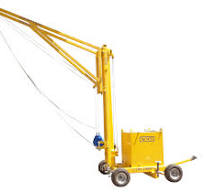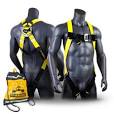The Importance of Fall Arrest Systems in Workplace Safety
Falls are one of the leading causes of workplace injuries and fatalities, especially in industries that involve working at heights. To mitigate this risk, fall arrest systems play a crucial role in ensuring the safety of workers who perform tasks at elevated locations.
What is a Fall Arrest System?
A fall arrest system is a form of personal protective equipment (PPE) designed to stop a person from falling when working at heights. It typically consists of an anchorage point, a body harness, and a connecting device. The system works by arresting the fall of a worker before they hit the ground, thus preventing serious injuries or fatalities.
The Components of a Fall Arrest System
Anchorage Point: The anchorage point is a secure structure to which the worker attaches their connecting device. It must be capable of supporting the weight and forces generated during a fall.
Body Harness: The body harness is worn by the worker and distributes the forces of a fall across the body to reduce injury risk. It should fit properly and be adjusted according to the individual’s size.
Connecting Device: The connecting device links the body harness to the anchorage point. This could be a lanyard or retractable lifeline that allows for movement while still providing protection in case of a fall.
The Benefits of Using Fall Arrest Systems
- Prevention of falls and potential injuries
- Compliance with safety regulations and standards
- Promotion of worker confidence and productivity
- Reduction in workplace accidents and associated costs
- Enhancement of overall workplace safety culture
In Conclusion
Employers have a responsibility to provide adequate fall protection measures for workers who are exposed to height-related hazards. Implementing proper training on fall arrest systems and ensuring their correct use can significantly reduce the risks associated with working at heights, ultimately creating safer work environments for all.
8 Essential Tips for Ensuring Safety with Fall Arrest Systems
- Always inspect your fall arrest system before use.
- Make sure your fall arrest system fits properly and is adjusted correctly.
- Use a full-body harness for better support and protection.
- Choose the right lanyard or lifeline for your specific job and environment.
- Regularly check and maintain all components of your fall arrest system.
- Receive proper training on how to use the fall arrest system correctly.
- Avoid swing falls by staying as vertical as possible during a fall.
- Replace any components of the fall arrest system that show signs of wear or damage.
Always inspect your fall arrest system before use.
It is crucial to always inspect your fall arrest system before use to ensure its integrity and effectiveness. Regular inspections help identify any signs of wear, damage, or malfunction that could compromise the system’s ability to protect you in the event of a fall. By taking the time to thoroughly check your equipment before each use, you can proactively address any issues and maintain a high level of safety while working at heights. Remember, a thorough inspection could make all the difference in preventing accidents and ensuring your well-being on the job.
Make sure your fall arrest system fits properly and is adjusted correctly.
It is crucial to ensure that your fall arrest system fits properly and is adjusted correctly. A well-fitted system distributes the forces of a fall evenly across the body, reducing the risk of injury. Proper adjustment of the system also ensures that it functions effectively in the event of a fall, providing the necessary protection to prevent serious accidents. By taking the time to adjust and fit your fall arrest system correctly, you are prioritizing your safety and well-being while working at heights.
Use a full-body harness for better support and protection.
When using a fall arrest system, it is crucial to prioritize safety by opting for a full-body harness. A full-body harness provides superior support and protection compared to other types of harnesses, as it distributes the forces of a fall across the entire body. This ensures that the impact is minimized and reduces the risk of serious injuries in case of a fall. Investing in a full-body harness is a proactive measure that can significantly enhance worker safety when working at heights.
Choose the right lanyard or lifeline for your specific job and environment.
When it comes to fall arrest systems, selecting the appropriate lanyard or lifeline for your particular job and work environment is crucial for ensuring maximum safety. The choice of lanyard or lifeline should take into account factors such as the height of the working area, potential fall distances, and the type of anchorage point available. By choosing the right equipment tailored to your specific needs, you can enhance the effectiveness of your fall protection system and minimize the risks associated with working at heights.
Regularly check and maintain all components of your fall arrest system.
It is crucial to prioritize the regular inspection and maintenance of all components within your fall arrest system. By conducting routine checks, you can ensure that each part, including the anchorage point, body harness, and connecting device, is in optimal working condition. This proactive approach helps identify any potential issues or wear and tear that could compromise the system’s effectiveness in the event of a fall. Regular maintenance not only enhances the overall safety of workers operating at heights but also prolongs the lifespan of the equipment, contributing to a safer work environment.
Receive proper training on how to use the fall arrest system correctly.
Receiving proper training on how to use the fall arrest system correctly is essential for ensuring workplace safety when working at heights. Understanding the components of the system, knowing how to properly fit and adjust the body harness, and learning how to connect to secure anchorage points are critical aspects of using the fall arrest system effectively. Comprehensive training not only reduces the risk of falls and injuries but also empowers workers to confidently navigate elevated work environments with the necessary skills and knowledge to protect themselves in case of a fall.
Avoid swing falls by staying as vertical as possible during a fall.
To prevent swing falls when using a fall arrest system, it is crucial to maintain a vertical position as much as possible during a fall. By staying upright, the risk of swinging uncontrollably and potentially hitting obstacles or structures is minimized. This tip emphasizes the importance of proper positioning and body control to enhance the effectiveness of the fall arrest system and reduce the likelihood of injury in case of a fall.
Replace any components of the fall arrest system that show signs of wear or damage.
It is crucial to regularly inspect and maintain your fall arrest system to ensure its effectiveness in preventing falls and protecting workers at heights. One important tip is to promptly replace any components that exhibit signs of wear or damage. By replacing worn or damaged parts, you can maintain the integrity of the system and minimize the risk of failure during a fall. Prioritizing the safety of workers by proactively addressing issues with the fall arrest system is essential for creating a secure work environment and preventing accidents.




